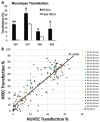2011 Rita Schaffer lecture: nanoparticles for intracellular nucleic acid delivery
- PMID: 22451256
- PMCID: PMC3380081
- DOI: 10.1007/s10439-012-0550-3
2011 Rita Schaffer lecture: nanoparticles for intracellular nucleic acid delivery
Abstract
Nanoparticles are a promising technology for delivery of new types of therapeutics. A polymer library approach has allowed engineering of polymeric particles that are particularly effective for the delivery of DNA and siRNA to human cells. Certain chemical structural motifs, degradable linkages, hydrophobicity, and biophysical properties are key for successful intracellular delivery. Small differences to biomaterial structure, and especially the type of degradable linkage in the polymers, can be critical for successful delivery of siRNA vs. DNA. Furthermore, subtle changes to biomaterial structure can facilitate cell-type gene delivery specificity between human brain cancer cells and healthy cells as well as between human retinal endothelial cells and epithelial cells. These polymeric nanoparticles are effective for nucleic acid delivery in a broad range of human cell types and have applications to regenerative medicine, ophthalmology, and cancer among many other biomedical research areas.
Figures




Similar articles
-
Subtle changes to polymer structure and degradation mechanism enable highly effective nanoparticles for siRNA and DNA delivery to human brain cancer.Adv Healthc Mater. 2013 Mar;2(3):468-80. doi: 10.1002/adhm.201200257. Epub 2012 Sep 26. Adv Healthc Mater. 2013. PMID: 23184674 Free PMC article.
-
Degradable polymer-coated gold nanoparticles for co-delivery of DNA and siRNA.Acta Biomater. 2015 Jan;11:393-403. doi: 10.1016/j.actbio.2014.09.020. Epub 2014 Sep 22. Acta Biomater. 2015. PMID: 25246314 Free PMC article.
-
Exploring the role of polymer structure on intracellular nucleic acid delivery via polymeric nanoparticles.J Control Release. 2015 Dec 10;219:488-499. doi: 10.1016/j.jconrel.2015.09.046. Epub 2015 Oct 1. J Control Release. 2015. PMID: 26433125 Free PMC article. Review.
-
Dual-targeting RNA nanoparticles for efficient delivery of polymeric siRNA to cancer cells.Chem Commun (Camb). 2020 Jun 18;56(49):6624-6627. doi: 10.1039/d0cc01848a. Chem Commun (Camb). 2020. PMID: 32463029
-
Non-viral Delivery Systems for Breast Cancer Gene Therapy.Curr Gene Ther. 2017;17(2):147-153. doi: 10.2174/1566523217666170606124131. Curr Gene Ther. 2017. PMID: 28595562 Review.
Cited by
-
Subtle changes to polymer structure and degradation mechanism enable highly effective nanoparticles for siRNA and DNA delivery to human brain cancer.Adv Healthc Mater. 2013 Mar;2(3):468-80. doi: 10.1002/adhm.201200257. Epub 2012 Sep 26. Adv Healthc Mater. 2013. PMID: 23184674 Free PMC article.
-
Polymeric nanoparticles for nonviral gene therapy extend brain tumor survival in vivo.ACS Nano. 2015 Feb 24;9(2):1236-49. doi: 10.1021/nn504905q. Epub 2015 Feb 10. ACS Nano. 2015. PMID: 25643235 Free PMC article.
-
Poly(β-amino ester) nanoparticle delivery of TP53 has activity against small cell lung cancer in vitro and in vivo.Mol Cancer Ther. 2013 Apr;12(4):405-15. doi: 10.1158/1535-7163.MCT-12-0956. Epub 2013 Jan 30. Mol Cancer Ther. 2013. PMID: 23364678 Free PMC article.
-
Evaluation of polymeric gene delivery nanoparticles by nanoparticle tracking analysis and high-throughput flow cytometry.J Vis Exp. 2013 Mar 1;(73):e50176. doi: 10.3791/50176. J Vis Exp. 2013. PMID: 23486314 Free PMC article.
-
The effect and role of carbon atoms in poly(β-amino ester)s for DNA binding and gene delivery.J Am Chem Soc. 2013 May 8;135(18):6951-7. doi: 10.1021/ja4002376. Epub 2013 Apr 29. J Am Chem Soc. 2013. PMID: 23570657 Free PMC article.
References
-
- American Cancer Society. Cancer facts and figures. 2005. Cancer facts and figures 2012: American Cancer Society.
-
- Gene therapy clinical trials worldwide. J Gene Medicine. 2012
-
- Acharya S, Sahoo SK. PLGA nanoparticles containing various anticancer agents and tumour delivery by EPR effect. Adv Drug Delivery Rev. 2011;63(3):170–183. - PubMed
-
- Anderson DG, Lynn DM, Langer R. Semi-automated synthesis and screening of a large library of degradable cationic polymers for gene delivery. Angew Chem Int Ed. 2003;42:3153–3158. - PubMed
-
- Arote RB, Jiang HL, Kim YK, Cho MH, Choi YJ, Cho CS. Degradable poly(amido amine)s as gene delivery carriers. Expert Opin Drug Deliv. 2011;8(9):1237–1246. - PubMed
Publication types
MeSH terms
Substances
Grants and funding
LinkOut - more resources
Full Text Sources
Other Literature Sources
Medical

